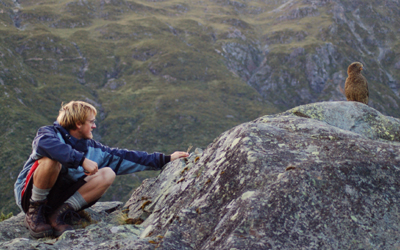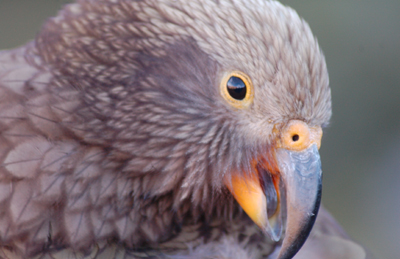My life as a keaologist
Guest blogger: Builder-cum-kea enthusiast Corey Mosen

Corey makes friends
This is the story of how I went from carting wheel barrow loads of sand down steep hills, attempting to build houses, to spending my time in the Mountains of Mt Aspiring National Park looking for, observing, and catching Kea.
First things first, I had to convince my boss that it was a good idea to let me take time off work, this wasn’t easy because it was the middle of summer when it is ideal weather and therefore more opportunities to work outside building, getting the most work done possible in the long day light hours. But I eventually persuaded him that it was a good idea and that it would eventually benefit his business in the long run because I’d work harder when I returned. I then went south for 10 days.
I arrived in Wanaka and met the people who I would be helping and then we drove to camp, past the turn off to Treble Cone Skifield. Camp wasn’t flash at all, it was in the middle of nowhere based around a little shearers hut. Little is the wrong adjective, this hut was tiny, about 2m x 2m and in it was a fire place, bench and 2 beds so there wasn’t much room to move at all. During dinner times we had 6 people in there so we all got to know one another quite intimately by the time we had finished the field trip. All six of us had tents based around the petite hut.
My tent was one of those dome tents and because of the extreme winds that flow through mountain valleys the top of my tent spent the first night clinging against my face, the poles couldn’t stand up against the wind and the tent was flattened for the entire night. Luckily the weather improved drastically and the rest of the trip was much more comfortable.
We were all there to help Clio Reid in her masters research on Kea, she was looking at the behavioural difference between Kea with high levels of lead in their blood and no lead in their blood and what impacts this has on Kea behaviour in the wild. Kea have been known to chew lead flashings and lead nails and it has developmental effects on the birds and therefore affect their ability to survive in the wild. I was told about the opportunity to volunteer by Tamsin Orr-Walker from The Kea Conservation Trust.

Close-up
We spent a week in the mountains with the aim to catch and process as many Kea as possible. The first night showed promise, a Kea came straight to the hut during dinner time, we place some bright shiny objects outside close to some noose mats and bingo we had a Kea. We weighed, measured, banded and took a blood sample and then let it go with the hope all Kea would be this easy to catch. Unfortunately the Kea in the area weren’t such easy targets.
Days were spent walking up the Rob Roy Glacier track which was a favourite haunt of Kea, there we caught and processed another two and proceeded to wait for more. But whether it was the time of the year or that Kea just didn’t feel like visiting that week, I’m not sure, but once the two resident Kea had been dealt with there was not much else to catch. Days were spent waiting, watching, talking to trampers, relaxing in the sun and even watching huge pieces of ice fall from the glacier. This wasn’t hard to miss because it sounded like thunder as the ice cracked and smashed on the rocks below the cliff. After a few days we got used to this routine, that is until the rain started, which made observations up in the mountains impractical so we had a day based around the hut.
Interesting events then unfolded. There were public toilets about 700m away from the hut and to get to them you had to cross a small creek which wasn’t bad at all during the fine weather but as the rain became torrential this became somewhat difficult. I thought climbing on the fence that went over the creek and sliding across would be a good way to get to the other side but in doing so I realised that this was indeed a terrible idea. It was electric, I found out the hard way. Being desperate for a toilet and now a little bit fried from the shock I quickly put my building skills to work and made a make shift bridge out of a few planks of wood and straddled the creek, I then ran at high speed to the loo.
The rain continued all day and to our surprise brought some kea back down to us, Kea that we hadn’t already processed. One in particular was feeding on a dead sheep that had been washed down the creek, so we used this as bait and placed a catch trap on it. It got itself caught up, all this while I was on the wrong side of the fence. I quickly and carefully made my way through the fence being sure to avoid the top wire, which I knew from my earlier experience was electric, but to my surprise I discovered that the bottom wire was also live. I was half way through the fence when in the process of pushing the second wire down to make more room for me to pass through it connected with the bottom wire and sent a bolt of electricity through my hand and out through my inner thigh, which was also touching the wire. I managed to free myself and got to the Kea, eager and again a little shaky, ready to help process it.
Being the first Kea that I had ever had the chance to hold I was quite eager to do a good job. I had watched all the others hold kea earlier in the week and took note on the correct techniques. I did the same as the others, but the others were all women and I being a man have hands that are quite a lot larger than theirs and their technique didn’t really work so well for me. Of course again I found out the hard way, the Kea was able to manoeuvre his head around and grab a hold the flesh of my hand, between my thumb and index finger. Kea don’t just bite and let go, they bite hold and twist. I was able to let Kate who was getting ready to weigh the bird know that he was biting me with a few quick remarks and she was able to swap the flesh of my skin for a toy that we were using to attract the birds. Once we had finished with the Kea I quickly disinfected the wounded, particularly concerned because this kea had been feeding on a dead sheep prior to us catching it. The wound healed fine but I have a scar as a reminder of that first intimate interaction with Kea. Maybe it was this encounter that made me strive to work with Kea in more ways in the future and gain some kind of revenge. But since then I have had many more successful adventures based around this magnificent bird and will hopefully have many more.
If you want to find out more about how you can volunteer for the Kea Conservation Trust see http://www.keaconservation.co.nz/.
Currently, the trust is looking for people to record the amount of kea throughout their natural range.
